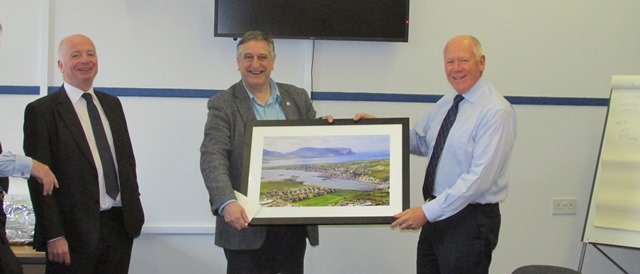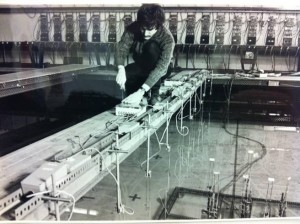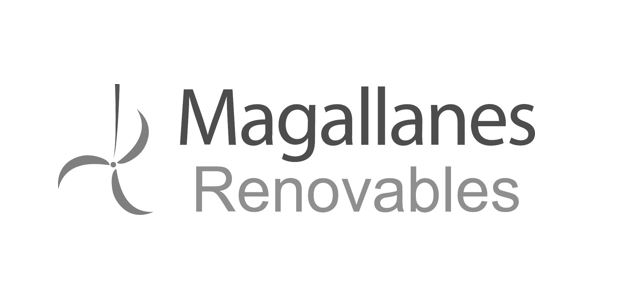Guest blog: Ian Bryden – Reflections on 35 years in marine energy
Ian Bryden stood down from the EMEC Board in May, having spent 10 years as a non-executive Director. However his journey in marine renewables started long before he joined EMEC. In this guest blog, Ian reflects on his time in marine renewables.

Presentation to Ian following his final EMEC Board meeting
It’s almost thirty five years now since I joined the marine energy sector, before there even was a marine sector in the way we now think of it. In September 1980, I became a PhD student, working with members of the University of Edinburgh Wave Energy Group, which was led by the famous Stephen Salter, whom many of us still think of as the “Father of Wave Energy”. It was an interesting time, with my career being directed by Stephen and by my supervisor Clive Greated. I owe both of them a huge debt of gratitude. After all of these years, I still exchange views and thoughts with both of them. In those days, the UK Department of Energy was funding wave energy research in the UK, with the ultimate target of building a 3GW wave power plant, sometime around 1990. It didn’t happen of course. Research into wave energy at that time didn’t move much beyond the laboratory, even if the old Edinburgh wide wave tank was a wonderful tool: when it was demolished in 2000, it was still the world’s most sophisticated wave facility and the one most capable of producing complex multidirectional waves, such as those off the west coast of the Orkney mainland.
Unfortunately, the UK government effectively cut off funding for wave energy research in 1982 after the publication of the “Wave Energy Select Committee” report. This was half way through my PhD, which was a bit of a downer to a young, enthusiastic student, who was convinced his work would save the world. It meant that I was unlikely to be able to develop a career in wave energy, unless there were some radical changes in political and corporate attitudes to a largely unquantified resource, with no proven technology for its development. Although the UK government saw no merit in wave energy, interest did not die totally in the UK. Many kept publishing research and Trevor Whittaker of Queens University Belfast, in particular, needs a special mention here. Using funding sources available in Northern Ireland, he and Alan Wells, of Wells turbine fame, continued development of the oscillating column wave energy device throughout what was a lean period for marine energy in the UK. If Stephen was the father of wave energy, Trevor was the nursemaid through the bad times.

Ian calibrating wave probes sometime around 1981
I went on to graduate and headed south to join the National Maritime Institute (NMI), which was part of the scientific civil service and which had part funded my PhD. NMI had a massive industrial test tank in Feltham, Middlesex and part of my research had been to develop a method to simulate multi-directional waves at a much larger scale than in the Edinburgh tank. I often think that the system I developed was the Betamax of the wave energy simulation market. It was elegant and much more sophisticated than the brute force approach used in most tanks of the time. However, today nobody uses “Multi-dimensional finite impulse response filters in wave tanks”. The rise in computer speeds meant that comparatively simple techniques involving the rather obvious method of adding together hundreds of simple wave forms could be performed with cheap hardware, while my methods required microprocessors held within each wave making flap. Ironically, the introduction of digital control within wave systems around twenty years later would have meant my methods would still have given significant advantages over the “obvious” way of doing business. But, just like Betamax was beaten by the less sophisticated VHS, the market had been cornered.
Just as politics had interfered with my PhD, my first job outside of academic research was to encounter a politically inspired glitch. Even before moving south, NMI had been privatised to become NMI Ltd. The finest array of marine testing facilities in Europe, including the Ocean Wave Basin, which was now equipped with the 2nd best type of wave generating software; the largest wave/tow tank in Europe, which was equipped with a simplified version of my generation system and the world’s deepest “absorption” cavitation tunnel, as well as a host of other test facilities, were passing into the private sector. After a couple of years, I realised that working in an organisation which was charged with maintaining massively expensive capital hardware, while reinventing itself as a lean and mean consultancy organisation was not for me. NMI Ltd was always going to struggle and in my last few months, it had been merged with another former state owned organisation to become BMT ltd, still in existence almost thirty years later, as a group of marine consultancy companies. Shortly after I made my career move back to Scotland to take up a lectureship with Heriot-Watt University, BMT announced it was closing the major test facilities and the UK lost its place as custodian of the best and largest marine laboratory test capability. Those tanks could have made an enormous difference to the marine energy sector had they survived just five years more!
When I arrived at Heriot-Watt, it was made clear to me that renewable energy was not a career enhancing activity for a young academic and for about four years I concentrated on applying my hydrodynamics to problems in the offshore oil and gas industry. It was not until a work related trip to Orkney in, I think, 1989 to visit the newly established International Centre for Island Technology (ICIT) in the Stromness Old Academy that renewable energy moved back into my sights. Actually ICIT was based in a porta cabin in the car park, as the offices were still being refurbished!
A brief trip to the north of the Orkney mainland to view the 3MW turbine on Burger Hill had me spending more time looking at Eynhallow Sound than the turbine. It was a spring tide and a couple of quick rough and ready calculations showed an energy flux which was greater than the electricity consumption of Glasgow. My interest was caught and I moved from Riccarton to join ICIT in Orkney, where I stayed for five years.
One of my biggest projects during that time had me studying the Fall of Warness as a potential tidal current energy site and generated what were the first journal papers on tidal current energy in the UK, including observations on the prospects of energy from the Pentland Firth. This was a European Commission funded project, also involving IT Power Ltd, which was a consultancy and development company specialising in energy opportunities in the developing world. The technical director of IT Power was Peter Fraenkel, who had some radical thoughts on technology that might be used to capture energy from currents. Peter had very recently led a project, funded primarily by Scottish Nuclear Ltd, to demonstrate a turbine designed to generate electricity in the fast moving currents of Loch Linnhe near Fort William. During the project Colin Bullen and I had spent many hours with old style recording current meters logging currents and even used a very early precursor of the now ubiquitous Doppler profilers. We had also spent a lot of time waiting for winds to subside. This was, and still is, a key issue in marine testing.
In 1996 I moved back to the mainland to become Head of the School of Mechanical and Offshore Engineering at the Robert Gordon University in Aberdeen. Almost as soon as I has sat down in the office, I had a telephone call from Peter Fraenkel who was keen to develop the Orkney work further. This led to a European funded project known as Opt-Current, which was a multinational study into the design principles for turbines matched to local conditions. It was during the project that Peter conceived the IT Power and MCT machines – SeaFlow and SeaGen – which were subsequently installed in the Bristol Channel and Strangford Lough. SeaFlow in particular formed the basis of the design calculations for OptCurrent. Peter and I had always assumed that the first SeaFlow type machine would be installed in Orkney but, in the end, IT Power took the decision that the Bristol Channel off Lynmouth was closer to their operating base. MCT Ltd was eventually spun out of IT Power to develop their next generation device, SeaGen.
It was about this time that I joined the board of EMEC Ltd. Andrew Mill was CEO at that time and Bill Edgar was just taking up his position as Chairman. It was also about the time where I first used the expression “The Saudi Arabia of Tidal Current Power”, during the very first All-Energy Conference, to describe the Pentland Firth. That expression has been used and abused way out of the original context in which it was used and has haunted me ever since. One newspaper in the United States even referred to me as “The Godfather of Tidal Power”, which amused me but I always felt that Peter Fraenkel had a better claim to the title.
It was an exciting time. We were on the cusp of a new industry. Wave and tidal current power was at last going somewhere. I had acted as one of three specialist advisors to the House of Commons Science and Technology Sub Committee for their wave and tidal energy enquiry in 2000 and a key recommendation had been the establishment of a full scale test site in the UK, in which machines could be proven in realistic conditions. It was one thing for a parliamentary committee making a recommendation and another thing to actually do it. If it hadn’t been for the determination of Highlands and Islands Enterprise, Orkney Islands Council and key figures such as Elaine Hanton and John Griffiths, it might never have happened (my apologies to the many others who played a key role here). Committees can only do so much, eventually it needs individuals to make things happen!
During my time at RGU, I conceived of my own tidal energy device, Brian the Iron Sea Snail, which wasn’t actually an energy converter but a mounting system stabilised by variable geometry hydrodynamic lifting surfaces. Although the original idea was mine, the real work was done by Alan Owen, who took an idea and turned it into a reality in steel. When I left RGU, Alan remained to take charge of the Snail project. There are a few observations from the project, not the least being that fifteen minutes of exposure to a high turbulence environment will teach you more than a lifetime of text books.
My move to the University of Edinburgh in 2006 also marked the start of my role as Research Director of the Engineering and Physical Sciences Research Council (EPSRC) funded Supergen Marine Research consortium. This has been a collaborative project, led by Professor Robin Wallace, involving most of the UK Universities involved in marine energy research. I had been a founding member of the consortium while with RGU, with particular responsibility for research associated with establishing a robust understanding of the tidal current resource, including issues associated with measuring and quantifying turbulence. Supergen, although it represented the cutting edge of academic research, always had a somewhat uncertain relationship with the industrial developers of marine energy. The funders insisted, not unreasonably given they were investing public funds, on open publication of findings, which did not sit well with commercial development. This diminished the effectiveness of the consortium, which would have benefitted from a closer relationship with the sector at large. Despite this, the consortium, over three rounds of funding, has increased the fundamental understanding of many aspects of the engineering science necessary to exploit the marine environment. I was always frustrated, however, with a feeling that more could be done and that a more productive relationship with the industrial partners could have been developed.
Outside of Supergen, I led the projects which resulted in the design and construction of the FloWave test facility in Edinburgh and still remain on the board of the company “spun out” of the University of Edinburgh to operate and manage what is the world’s most advanced wave and tidal current laboratory. I am delighted that EMEC and FloWave have signed an agreement to explore opportunities for future working. The world’s best (by far) full and mid-scale test facility working with the world’s best (by far) laboratory test facility represents a powerful opportunity for the marine sector.
Just over a year ago, I left Edinburgh to take my present position as the first Vice Principal for Research at the University of the Highlands and Islands. Just as the formation of EMEC represented a brave statement of confidence in a developing industrial sector, UHI represents a statement of intent, and a determination that the future development of the Highlands and Islands will be underpinned by a highly educated work force and by state of the art research embedded in the region. My links with Orkney will continue and I am sure the Old Academy has not seen the end of me yet!
Best wishes to you all.
Ian





